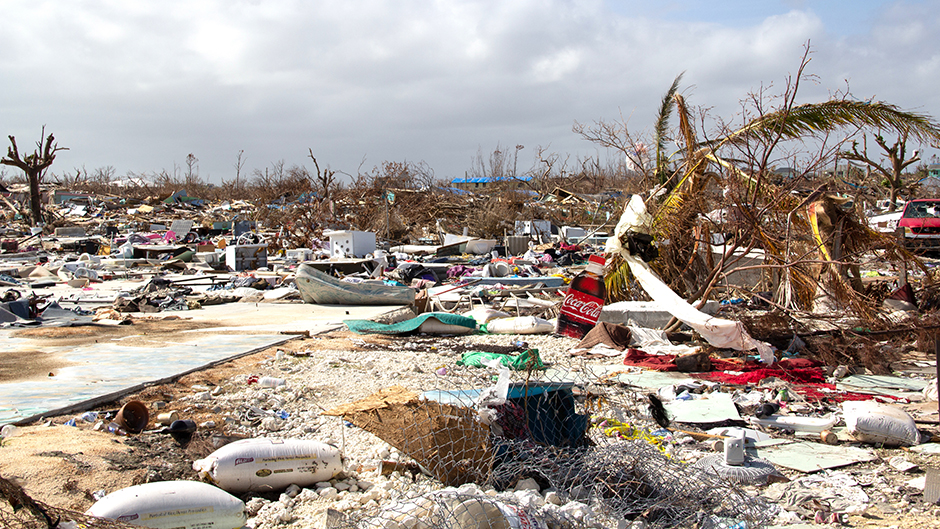Hurricane Dorian’s catastrophic trek across the northwest Bahamas highlighted one of the cruelest ironies associated with the changing climate: the small-island states that produce negligible greenhouse gas emissions are among the most vulnerable to hurricanes that have grown stronger, wetter, and slower-moving over the decades.
Led by James M. Shultz, a population health scientist at the University of Miami Miller School of Medicine, four health and climate experts note in The New England Journal of Medicine that Atlantic and Caribbean island-based populations that contribute “virtually nothing to climate change” are among those most at the risk from the carbon emissions produced by higher-income countries.
“These escalating effects on population health represent a double environmental injustice: socioeconomically disadvantaged and marginalized populations sustain disproportionate harm and loss, with more hazardous storms exacerbating the inequity,” Shultz and his coauthors wrote in a perspective piece the journal published online Wednesday. “The increased incidence of climate change-related storms portends a worsening impact on marginalized people that can exacerbate preexisting health gaps and social inequities.”
Shultz, the director of the Center for Disaster and Extreme Event Preparedness (DEEP Center) in the Department of Public Health Sciences, and two of his coauthors—James P. Kossin, an atmospheric scientist with the National Oceanic and Atmospheric Administration’s National Centers for Environmental Information, and Sandro Galea, dean of the School of Public Health at Boston University—have collaborated on previous articles sounding the alarm about the growing risks created by climate-driven changes in Atlantic hurricanes, including the mental health consequences they pose for vulnerable populations. But for their latest endeavor, they also collaborated with Dr. Duane E. Sands, who has a deeply personal interest in the subject.
Sands is the minister of health for the Bahamas and met Shultz during meetings with University leaders on how the University can contribute to his nation’s recovery from Hurricane Dorian, which as their article notes, dramatically highlighted how manmade climate change amplifies storm hazards that disproportionately affect impoverished communities.
“As Dorian moved over the northwest Bahamas, for instance, the most severe destruction affected thousands dwelling in shantytowns on Great Abaco Island,” the authors wrote. “Many of those affected were undocumented migrants. Similarly, after Hurricane Harvey, flooding around Houston was worst in socioeconomically deprived neighborhoods with higher proportions of black and Latino residents. And after Hurricane Maria, many rural, disadvantaged Puerto Rican municipalities struggled without electricity for as long as a year. The death toll rose steadily into the thousands, as frail, elderly, and chronically ill people died preventable deaths.”
Collectively, the authors said, the Caribbean’s 44 million residents generate just 0.4 percent of the world’s total global carbon emissions, with the Bahamas producing well below 0.01 percent. But given their geographic locations, the 29 Caribbean islands designated as “small-island states” by the United Nations have endured the brunt of increasingly harmful Atlantic storms like Dorian, which broke numerous records. After intensifying at an unprecedented rate, Dorian slammed into Great Abaco Island on Sept. 1 with record-tying 185-mph winds, then stalled over Grand Bahama Island for 40 hours, resulting in what the authors called “one of the most prolonged known population exposures to extreme hurricane hazards."
But despite its distinguishing features, the authors said Dorian “fits into a discernible pattern,” with Hurricane Matthew ransacking Haiti’s breadbasket in 2016 and, in 2017, Hurricane Irma unleashing Category 4 or 5 winds on eight small-island states and Hurricane Maria pummeling 16 island states. “All told,” the authors said, “22 of 29 Caribbean small-island states were affected by at least one 2017 storm.”
Compounding the social injustices, the authors said, small-island states also face more post-storm vulnerabilities than their bigger and richer neighbors because many of the resources needed for recovery—trucks, cars, supplies, shelters, and volunteers—have been decimated.
“These multiplicative effects further magnify social injustice” and contribute to “widening health gaps” that compel action on several fronts, the authors said. Among them, they wrote, is to increase collaborations among climate scientists, population health scientists, and clinicians to better plan the health response to hurricane-affected communities—and to add their voices to the public conversations about climate-related disasters.
“Sea levels will not recede, average global temperatures will not decline, and hurricane hazards will not moderate,” they concluded. “We need to prepare now for future Dorian-like scenarios in a manner that redresses environmental injustice.”

